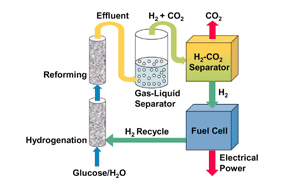Renewable hydrogen by aqueous-phase reforming of glucose†
Abstract
Hydrogen can be produced from aqueous solutions containing 10 wt%

* Corresponding authors
a
University of Wisconsin, Madison, 1415 Engineering Drive, Madison, Wisconsin 53706, USA
E-mail:
dumesic@engr.wisc.edu
Fax: 1 608 262 5434
Tel: 1 608 262 1095
Hydrogen can be produced from aqueous solutions containing 10 wt%

 Please wait while we load your content...
Something went wrong. Try again?
Please wait while we load your content...
Something went wrong. Try again?
R. R. Davda and J. A. Dumesic, Chem. Commun., 2004, 36 DOI: 10.1039/B310152E
To request permission to reproduce material from this article, please go to the Copyright Clearance Center request page.
If you are an author contributing to an RSC publication, you do not need to request permission provided correct acknowledgement is given.
If you are the author of this article, you do not need to request permission to reproduce figures and diagrams provided correct acknowledgement is given. If you want to reproduce the whole article in a third-party publication (excluding your thesis/dissertation for which permission is not required) please go to the Copyright Clearance Center request page.
Read more about how to correctly acknowledge RSC content.
 Fetching data from CrossRef.
Fetching data from CrossRef.
This may take some time to load.
Loading related content
